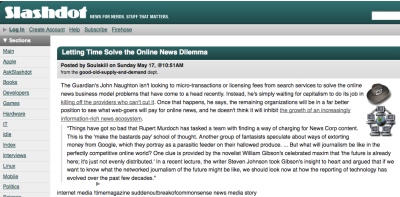The New York Times staff photographers have a nice blog.
Are Your “Secret Questions” Too Easily Answered?
In a word, yes.
In research to be presented at the IEEE Symposium on Security and Privacy this week, researchers from Microsoft and Carnegie Mellon University plan to show that the secret questions used to secure the password-reset functions of a variety of websites are woefully insecure. In a study involving 130 people, the researchers found that 28 percent of the people who knew and were trusted by the study’s participants could guess the correct answers to the participant’s secret questions. Even people not trusted by the participant still had a 17 percent chance of guessing the correct answer to a secret question.
“Secret questions alone are not as secure as we would like our backup authentication to be,” says Stuart Schechter, a researcher with software giant Microsoft and one of the authors of the paper. "Nor are they reliable enough that their use alone is sufficient to ensure users can recover their accounts when they forget their passwords.”
The least-secure questions are simple ones whose answers can be guessed with no existing knowledge of the subject, the researchers say. For example, the answers to the questions “What is your favorite town?” and “What is your favorite sports team?” were relatively easy for participants to guess. All told, 30 percent and 57 percent of the correct answers, respectively, appeared in the top-five list of guesses.
Ansel Adams unveiled
Marc Silber’s Photo Show with Ansel Adams’ son Michael from SilberStudios.Tv on Vimeo.
Just stumbled on this fascinating interview with Michael Adams, Ansel’s son, recorded at Glacier Point in Yosemite. It brought back lots of memories. Sue and I once spent a magical day in Yosemite in July 1990. The strange thing was that while I had, as usual, brought a camera with me, I found myself unable to take any pictures. The reason was that I felt that nothing I could do would ever be adequate because Ansel Adams had ‘done’ Yosemite. So, in the end, the camera stayed in the bag. But I did strip off and swam in the Merced river while Sue sat on the bank in the sunshine and wondered whether photographer’s block was a recognised medical condition.
Technology news from the soaraway Sun
From the Sun’s website. (Yes, it does have one.)
A MIRACLE new smart-bra that BOOSTS a woman’s cleavage when she feels sexy is being tested by lingerie designers.
The magic bra detects changes in body temperature brought on by sexual arousement and squeezes boobs together to create a bigger cleavage.
Then when things cool off again the bra’s built-in memory relaxes the fabric and the wearer’s bust returns to normal, say its Slovenian inventors.
(Upper case in original, btw.)
Thanks to Jack Schofield, from whom nothing is hidden, for the link.
Anybody here an MP and speak English?
“He has sadly become part of the problem. It is time for him to go”
Jo Swinson, Liberal Democrat MP, on the Speaker of the House of Commons. Quoted in today’s Observer.
Presumably s/he meant to say “Sadly, he has become part of the problem.”
Bah!
Meetings 2.0
I must be getting old: I find myself agreeing with Steve Ballmer. There’s a terrific interview with him in today’s NYT. I particularly like this bit:
Q. What’s it like to be in a meeting run by Steve Ballmer?
A. I’ve changed that, really in the last couple years. The mode of Microsoft meetings used to be: You come with something we haven’t seen in a slide deck or presentation. You deliver the presentation. You probably take what I will call “the long and winding road.” You take the listener through your path of discovery and exploration, and you arrive at a conclusion.
That’s kind of the way I used to like to do it, and the way Bill [Gates] used to kind of like to do it. And it seemed like the best way to do it, because if you went to the conclusion first, you’d get: “What about this? Have you thought about this?” So people naturally tried to tell you all the things that supported the decision, and then tell you the decision.
I decided that’s not what I want to do anymore. I don’t think it’s productive. I don’t think it’s efficient. I get impatient. So most meetings nowadays, you send me the materials and I read them in advance. And I can come in and say: “I’ve got the following four questions. Please don’t present the deck.” That lets us go, whether they’ve organized it that way or not, to the recommendation. And if I have questions about the long and winding road and the data and the supporting evidence, I can ask them. But it gives us greater focus.
I’d go further. When I’m Supreme Leader all the chairs will be removed from committee meeting rooms.
The serious point behind Ballmer’s Meetings 2.0 is not so much that it’s efficient (which it is) but that it means that each meeting adds value or moves things on. And, in a way, that’s the whole point of our networked information ecosystem. One can often assume nowadays that anyone who’s prepared to put in a little effort can be as well informed as you are. So the question then becomes: how can s/he or we add value and move us on?
I tried to make this point in my seminar last week at the Reuters Institute in Oxford. I said I was sick and tired of seeing an expensive TV journalist being filmed outside the door of 10 Downing Street telling me stuff that I already know. I want him or her to move the story on, not waste airtime and bandwidth in useless summary or colourful waffle.
The other really interesting point to emerge from the Ballmer interview is that his favourite ‘management’ book is Bill Collins ‘Built to Last’.
Networked news
This morning’s Observer column.
As newspapers fold, the hunt is on for a workable business model for online news. Lots of things are being tried, but none of them provides the revenue growth needed to offset the income siphoned off by changes in media consumption patterns and the diversion of advertising revenues to the web.
Things have got so bad that Rupert Murdoch has tasked a team with finding a way of charging for News Corp content. This is the “make the bastards pay” school of thought. Another group of fantasists speculate about ways of extorting money from Google, which they portray as a parasitic feeder on their hallowed produce. And recently a few desperadoes have made the pilgrimage to Capitol Hill seeking legislative assistance and/or federal bailouts for newspapers.
It’s difficult to keep one's head when all about one people are losing theirs, but let us have a go…
Coincidentally, there have been (at least) two other pieces on this general theme this week — an uncharacteristically Daily Mail-type rant by Bryan Appleyard in the Sunday Times, and an excellent, balanced article in the Economist.
And I’ve been Slashdotted! In the old days, that would mean that the Observer’s servers would fall over.
Later: This is probably all due to Cory blogging the column in BoingBoing. And the biggest irony is that the piece didn’t appear in today’s paper edition of the Observer. No idea why, but I suspect a glitch in the paper’s content management system.
Coming soon: the Global Approximation System
From Good Morning Silicon Valley.
If the Air Force and its contractors don’t get their act together pretty quickly, in a couple of years your car’s navigation system may be giving you instructions like “In a mile or so, turn right” or “You have reached your destination, more or less.” The Air Force is responsible for maintaining and modernizing the network of satellites that provides GPS service, but according to a new Government Accountability Office report, technical problems, leadership lapses and contractor woes have combined to put things way behind schedule. “As a result,” said the report, “the current IIF satellite program has overrun its original cost estimate by about $870 million and the launch of its first satellite has been delayed to November 2009 — almost three years late.”
The problem is that the GPS system needs a constellation of at least 24 satellites to deliver complete coverage and accurate results, and some of the birds now flying have been up there almost 20 years. If they start to fail before replacements are up, GPS accuracy will start to deteriorate. As things stand, the report concluded, “it is uncertain whether the Air Force will be able to acquire new satellites in time to maintain current GPS service without interruption. If not, some military operations and some civilian users could be adversely affected.”
Bah! And just when I was getting to rely on it for getting to Norham Gardens.
More Celtic Donkey news
From the every-cloud-has-a-silver-lining department. This from the front page of today’s Irish Times.
In an unforgiving recession that has led to a collapse in demand for many trappings of the luxury lifestyle, Ireland’s best-known helicopter company has ceased its charter service.
Celtic Helicopters, controlled by businessman Ciarán Haughey, returned its air operations certificate to aviation regulators yesterday.
The firm now plans to focus on hangaring services for helicopter owners who are mothballing aircraft to curtail their day-to-day outgoings.
The firm offered business travel and aerial photography services, as well as pleasure trips, golf tours and transfers to race meetings.
Although helicopter trips became a symbol of spectacular wealth accumulation in the boom times, they are no longer in vogue. The chopper, for example, was a favoured mode of transportation among property developers. Now many members of that community are under considerable fiscal strain. Celtic is making five staff redundant as a result of the decision to halt charter services, but it will continue to employ another eight.
Knowledgeable readers will recall that Celtic’s owner is the son of Charlie Haughey, the disgraced gangster who was, for a time, Ireland’s Taoiseach (Prime Minister). Celtic Aviation prospered during his reign — and of course during the boom.
Who says Twitter is frivolous?
Heh! Here’s something to make the Twitter-deniers choke on their muesli. The Herschel-Planck space mission is now well on its way. Needless to say, it has a good website. The mission has launched two spacecraft. Herschel is the largest, most powerful infrared telescope ever flown in space. Planck is
Named after the German Nobel laureate Max Planck 1858-1947, ESA’s Planck mission will be the first European space observatory whose main goal is the study of the Cosmic Microwave Background – the relic radiation from the Big Bang.
Observing at microwave wavelengths, ESA’s Planck observatory is the third space mission of its kind. It will measure tiny fluctuations in the CMB with unprecedented accuracy, providing the sharpest picture ever of the young Universe — when it was only 380 000 years old — and zeroing-in on theories that describe its birth and evolution.
Planck will measure the fluctuations of the CMB with an accuracy set by fundamental astrophysical limits.
But now comes the really neat bit: Planck has a Twitter feed! It curently has 360 followers — and, understandably, isn’t following anyone. Probably has enough to do as it hurtles through space.
(Yeah, yeah, I know: the Tweets are done by some geek in ESA. But still… A friend of mine’s husband is one of the leading scientists behind the project. He was a bit miffed when she sent him a message this morning telling him that some complex manoeuvre had been successfully completed. She knew before he did, because she’s a Twitterer and he’s not).


